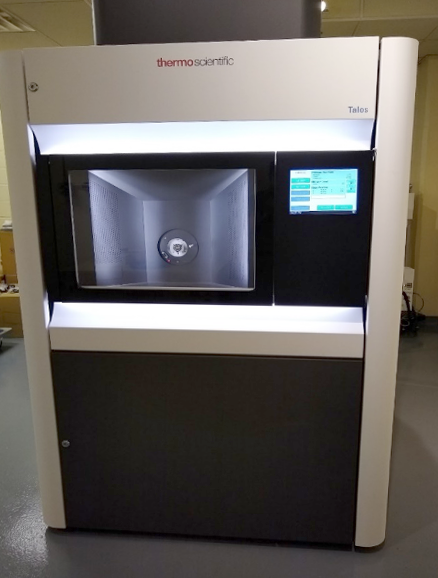Thermo Fisher Talos F200X G2 Scanning Transmission Electron Microscope
 The scanning transmission electron microscope (S/TEM) with multiple energy dispersive spectrometers (EDS) and a High Angle Annular Dark Field (HAADF) detector is used to characterize materials on the nanoscale, enabling their exploitation in applications relevant to energy conversion/storage, catalysis, microelectronics/sensing, medicine, and metallurgy.
The scanning transmission electron microscope (S/TEM) with multiple energy dispersive spectrometers (EDS) and a High Angle Annular Dark Field (HAADF) detector is used to characterize materials on the nanoscale, enabling their exploitation in applications relevant to energy conversion/storage, catalysis, microelectronics/sensing, medicine, and metallurgy.
This instrument provides:
- Conventional TEM bright-field/dark-field imaging, electron diffraction, and high-resolution TEM imaging
- Z-contrast (HAADF) imaging capability at 0.16 nm resolution;
- Fast EDS elemental mapping
- Acquisition of tilt series with TEM/STEM/EDS capability and 3D reconstruction
- Alignments at both 200kV and 80kV for material and tissue samples, respectively
This instrument is both a user-based and fee-for-service instrument.
Location
A. Paul Schaap Chemistry Building, Room 53
Statement of acknowledgment
The Talos F200X G2 S/TEM was funded through an NSF MRI grant. Please acknowledge the use of this instrument in your publications, presentations, and dissertations. A suggested statement can read: "This work made use of the Talos F200X G2 S/TEM that is funded in part through NSF MRI award #2018587."
User groups
- Stephanie Brock group, Department of Chemistry
- Long Luo group, Department of Chemistry
- Shengyi (Iris) Sun group, School of Medicine
- Leela Arava group, College of Engineering
- Eranda Nikolla group, College of Engineering
- Yingxi Elaine Zhu group, College of Engineering
User training
User training is scheduled with Dr. Mei through (zmei@chem.wayne.edu). Training will be conducted in two parts: 1) TEM and 2) STEM. Once user competency is demonstrated, the user will be able to perform experiments without supervision by scheduling through the instrument management system.
Publications
Batugedara, T. N.; Brock, S. L. “A Little Nickel Goes a Long Way: Ni Incorporation into Rh2P for Stable Bifunctional Electrocatalytic Water Splitting in Acidic Media,” ACS Materials Au, 2023 3, 299.
Amarasinghe, D. K.; Dissanayake, K. T.; Dhanapala, D. B.; Rabuffetti, F. A. “Local atomic environment of Yb3+ in alkaline-earth fluorohalide nanocrystals,” CrystEngComm, 2022, 24, 531.
Yang, J.; Wang, G.; Teixeira, A. P.; Silva, G. G.; Hansen, Z.; Jamal, M. J. M.; Mathew, K.; Xiong, J.; Zhou, T.; Mackowiak, M.; Fleming, P. D.; Wu., Q. “A biomass-based cathode for long-life lithium-sulfur batteries,” Electrochemistry Communications, 2022, 140, 107325.
Dhanapal, B. D.; Munasinghe, H. N.; Dissanayake, K. T.; Suescun, L.; Rabuffetti, F. A. “Expanding the synthetic toolbox to access pristine and rare-earth-doped BaFBr nanocrystals,” Dalton Transactions, 2021, 50, 16092.
Geng, X.; Li, S.; Mawella-Vithanage, L.; Ma, T.; Kilani, M.; Wang, B.; Ma, L.; Hewa-Rahinduwage, C. C.; Shafikova, A.; Nikolla, E.; Mao, G.; Brock, S. L.; Zhang, L.; Luo, L. “Atomically dispersed Pb ionic sites in PbCdSe quantum dot gels enhance room-temperature NO2 sensing,” Nature Communications, 2021, 12, 4895.